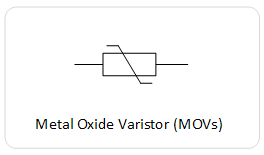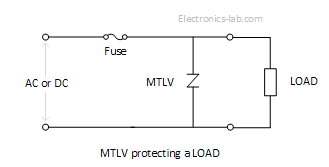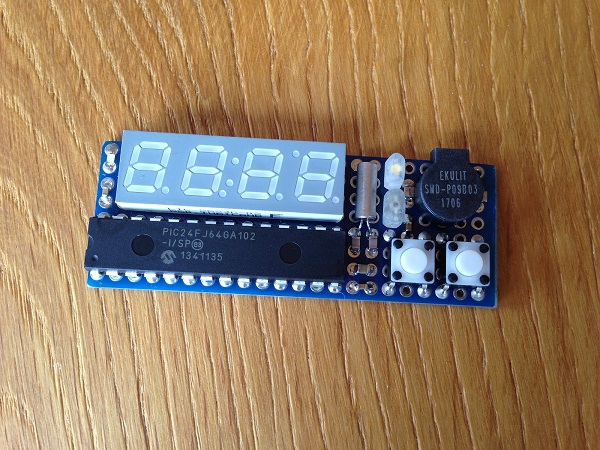Repair of PXI-2596 (Microwave Switch), PXI-4461 (Signal Analyzer) & PXI-4071 (7.5 Digit FlexDMM) – [Link]
The DigiRule – a digital ruler
Brad has designed a cool binary PCB ruler, The DigiRule:
So I made the DigiRule! – The DigiRule is a 15cm (6″) ruler with which is marked in binary digits rather than decimal. It has a number of built in digital functions including: logic gates, flip flops, counters etc.
The DigiRule – a digital ruler – [Link]
4 CHANNEL INFRARED REMOTE MODULE
4 Channel Infrared (IR) Remote is a simple project using the popular HT12A and HT12D encoder / decoder chips from Holtek.
Specifications
- Supply – Transmitter: 2.4 ~ 5 VDC, 5 V @ 20 mA & Receiver: 5 ~ 6 VDC, 5 V @ 50 mA
- Output – 4 Latched/Momentary TTL compatible outputs
- Crystal based oscillator for reliability of operation
- DIP switch selectable 8 bit address code
- LED output to indicate reception
- ON/OFF slide switch in the transmitter
- Power-On LED indicator in the Receiver / Transmitter
- High noise immunity
- Berg connector for interfacing of the board
- Four mounting holes of 3.2 mm each
- PCB dimensions – Transmitter: 61 mm x 47 mm & Receiver: 46 mm x 46 mm
4 CHANNEL INFRARED REMOTE MODULE – [Link]
4 Channel Infrared Remote Module
4 Channel Infrared (IR) Remote is a simple project using the popular HT12A and HT12D encoder / decoder chips from Holtek.
Specifications
- Supply – Transmitter: 2.4 ~ 5 VDC, 5 V @ 20 mA & Receiver: 5 ~ 6 VDC, 5 V @ 50 mA
- Output – 4 Latched/Momentary TTL compatible outputs
- Crystal based oscillator for reliability of operation
- DIP switch selectable 8 bit address code
- LED output to indicate reception
- ON/OFF slide switch in the transmitter
- Power-On LED indicator in the Receiver / Transmitter
- High noise immunity
- Berg connector for interfacing of the board
- Four mounting holes of 3.2 mm each
- PCB dimensions – Transmitter: 61 mm x 47 mm & Receiver: 46 mm x 46 mm
Schematics
Parts Lists
Transient Voltage Suppressors
Voltage suppressors are used to protect circuits from unwanted transients, when other devices like diodes and capacitors fail to do so. Transient effects have various sources and are able to damage the connected parts and ICs if not properly measures taken. In this article we will discuss about the various transient voltage suppressors and their uses. We will cover, TVSs, Varistors, Multilayer Varistors, Surgestors and Polyswitches etc.
Bypass Capacitors
Bypass capacitors are very often used in logic and power systems to reduce unwanted voltages to reach ICs and other sensitive parts and to clean the power rails, but are limited to low power applications such as RC snubbers and decoupling of digital logic rails. For decoupling a digital rail a capacitor in the range of 0.01-0.22uF is often used and for decoupling a power rail a 0.1uF and up is used, connected form power line to ground. Capacitors are low cost, simple to apply, have fast action and are bipolar but have uneven suppression and may fail unpredictably.
Zener Diodes
Zener diodes are also used to protect sensitive circuits from unwanted voltages in a way of clamping low energy systems that run at high frequencies such as high speed data lines. They are low cost, fast in action, have specific clamping voltage, they are easy to be used and work bidirectional, but can only handle low energy and fail open (which can hurt the circuit). They are mostly used for regulation than transients.
Transient Voltage Suppressor Diodes (TVS)
Transient voltage suppressor diodes or TVSs are semiconductor devices used to clamp transient voltages and current, such as electrostatic discharge, inductive switching kickback, induced lighting surges etc. TVS are used for diversion or clamping in low voltage and low energy, modest frequency systems and are way more reliable than a diodes. They come in unipolar and bipolar versions. Unipolar TVS breaks down when the specified breakdown voltage is exceeded and pass current in one direction, in the opposite direction of the arrow. In contrast bipolar TVS can handle current in both directions. TVS are invisible to the circuit they are placed to until a transient appears. When a transient appears, TVS clamps instantly to limit the spike to a safe voltage level. The breakdown voltage of TVS should be selected to have a breakdown voltage greater than the working voltage of the circuit protecting. Some of the advantages of TVS is that they are fast, easy to use and fail with short-circuit. Some of the disadvantages is that their high capacitance limits the frequency they can be used, they can be used in low energy systems and are more expensive than Zener diodes and MOVs.
Metal Oxide Varistors (MOVs)
Metal oxide varistor or MOV is a bidirectional semiconductor device that acts like a voltage sensitive variable resistor. It’s made of various metal oxide p-n junctions placed in various directions and when the voltage across its leads exceeds a specified voltage they appear to have a very small resistance. The breakdown voltage is defined during the manufacturing process and can pass current in both directions, so can be used in DC and AC circuits. MOVs are fast, low cost, easy to use and handle more power than TVS. Also when they fail they short circuit. The disadvantage of MOVs is that they have moderate to high capacitance, thus limiting their use in lower frequency systems. MOVs are usually placed across mains input along with a series filter inductor and a fuse to protect the MOV itself. When a transient appears they switch from high resistance to low resistance this passing the excess current through. They can absorb a large amount of power for short periods of time and smaller amount of power for longer periods.
Multilayer Varistor (MLTV)
Multilayer Varistor or MLTV is a surface mount variation of MOV. Due to the surface mount contacts MLTVs have lower self-inductance and series resistance allowing for much quicker response times, typically less than 1 ns. The energy rating of MTLV are lower than other types of varistors but they can survive many thousands of strikes at full rated peak current. They are used on low voltage (3-70V) systems with modest frequencies. They are fast, compact and bidirectional, but more expensive than other MOVs and their high capacity limits their use on high frequency systems.
Surgector
The surgector uses a silicon thyristor technology to provide bidirectional “crowbar” clamping action for transients. Surgectors remain in a reverse bias state as long as the voltage across is it is below breakdown voltage. If a transient voltage appears then the device breakdowns beginning the clamping action. If the transient voltage rises higher until the breakover voltage is reached a thyristor action is triggered and the surgector latches to ON state, thus short circuiting the transient voltage.
Polyswitch
A polyswitch is a positive temperature coefficient resistor that stops the current from passing when a specified temperature is reached. In normal temperatures the resistance is low and current passes through easily. When the current rises enough (trip current) then resistance is increased dramatically and current flow drops. The polyswith will reset if the holding current is reduced and the device is cooled to normal temperatures. They often used in speakers, power supplies, battery packs, motors etc. They are low cost and easy to use, but requires a cooling down period to reset.
Avalance Diodes
Avalance diodes are designed to break down and conduct at a specified reverse-bias voltage. Their operation is similar of a Zener diode but the breakdown occurs using the avalance effect. Unlike Zener diodes, avalance diodes are available with high breakdown voltages as high as 4000V. They are placed in circuit in reverse biased direction and in this state they don’t interfere with the circuit. If the voltage across it exceeds the breakdown voltage then the diode passes the excess current to ground. Avalance diodes are often used in low voltage, high speed logic applications and are very fast (<1ns response). Also their shunt capacitance is low (50pF).
Gas discharge and Spark Gap TVSs
Gas discharge and spark gap TVSs are used for diversion of current in very high energy and high voltage applications. Their high energy capability can go up to 20kA and their leakage current is in pA range. Disadvantages of them is that cost more than other methods and are slow in response.
Transient Suppressor Examples Uses
TVS examples

MOV Example
MTLV Example
Surgector Example
PolySwitch Example
PIC24 bedside table alarm clock
Markus Gritsch posted pictures and code of his PIC24 bedside table alarm clock:
Another year, another clock, but for the first time for my alarm clocks. I am not using an MSP430 but a PIC24 instead. Standby current is with 5.5 µA only slightly higher than that of my MSP430 based ones. Time keeping is done using the RTCC pheripheral, which I also used for the first time.
It can be seen in action in this YouTube video
Friendly green digits 🙂
And of course it has a LiFePO4 battery on its back, being charged every few years using my new USB charger.
A photo transistor is also included to dim the display in the dark. Much nices to the eyes when checking what time it is in the middle of the night.
PIC24 bedside table alarm clock – [Link]
3A Variable Bench PSU with Color Display
by SHARANYADAS @ instructables.com:
I am playing with electronics since i was a child and made numerous circuits.But still now,i didn’t made any power supply unit for general purpose use.So tired of making PSU for each circuit,I decided to make a stable Bench PSU for general purpose use with some enhanced features.I decided to made the core power supply analog controlled and extra features digitally controlled. So that’s why i choose LM350 linear regulator chip as the heart because 3A is sufficient for day to day use.
3A Variable Bench PSU with Color Display – [Link]
Electronic Live Capture Mousetrap
A mousetrap is a type of animal trap specialize to catch small animals, particularly rodents like rats, mice, hamsters, etc. This project is a kind of mousetrap that is intended to keep a captured animal alive. In this way, the hunter can release the captured animal later to the wild.
The PIC12F683 microcontroller acts as the heart of the project; it is programmed to meet function of the design. The sensor used in this project is a pair of infrared transmitter and receiver. An infrared LED connected to the GP2 pin of the PIC12F683 transmits continuous infrared signal to the TSOP1138 infrared receiver connected to the GP1 pin of the PIC12F683. To avoid the effect of ambient light, the generated signal at GP2 pin to the infrared LED is modulated at 38kHz frequency. Once the infrared beam is broken, the GP1 input changes, thus, the PIC12F683 reacts by triggering the GP4 pin connected to the BS170 MOSFET that act as a switch of the relay. The relay switch is set to shut the door when triggered. A push button connected at GP3 pin of the PIC12F683 is used for reset.
This project has a simple concept; the trap is built on a box fitted for a rodent to enter. The bait is placed inside the box to lure the rodent in. A sensor will be triggered once the rodent is inside the box, then a single door will shut lock behind the captured rodent.
Electronic Live Capture Mousetrap – [Link]
Makerarm – The first robotic arm that makes anything, anywhere
Makerarm just lauched on kickstarter. It’s a penknife for the DIY world, it can make almost anything by changing the toolhead!
A complete digital fabrication system for makers everywhere: 3D print, laser, carve, plot, assemble, pick/place + more on your desktop!
- Makerarm works with interchangeable heads for countless applications.
- It 3D prints: Makerarm is not confined to a box and can 3D print with both filament and resin.
- It carves and mills: Makerarm includes high-speed desktop milling (light duty) and carving. You can mill on a variety of materials including plastics, wood, and soft metals right on your desktop. You can even hook up heavy duty flex shaft tools such as the Dremel Fortiflex to Makerarm for power-carving, grinding, or shaping applications (with speeds up to 23,000 RPM!).
- It laser engraves: Makerarm’s high power 500mW laser head (405nm) engraves and etches on plastics, wood, leather, cardboard, and more.
- It picks and places: Choose from vacuum pump coupled suction cups, electromagnetic heads, or grippers to carry out pick and place operations.
- It assembles: With the assembly heads, you can automatically place and fasten screws, carry out gluing, and perform pick and place functions.
- It’s a PCB fab: PCB milling, drilling, solder-paste dispensing, pick and place assembly (PCBA), and automated soldering take the hassle out of prototyping.
Makerarm – The first robotic arm that makes anything, anywhere – [Link]
The femtocell technology
by Slovati @ dev.emcelettronica.com:
Femtocells are basically low-power wireless access points that operate inside licensed frequency bands for connecting standard mobile devices with a provider’s network, using a broadband connection such as the DSL or a cable connection (basically using the best Internet connection available at that point). A femtocell is therefore an indoor base station that allows you to make phone calls with your mobile cellular using the Internet service avaialble locally; it is able to do that because femtocell is a transceiver that operates on the same frequencies of mobile phones, all within a home or office. When you connect with a mobile device to a femtocell, therefore, you do not use directly the provider’s mobile network, but you use the base station.
The femtocell technology – [Link]

































